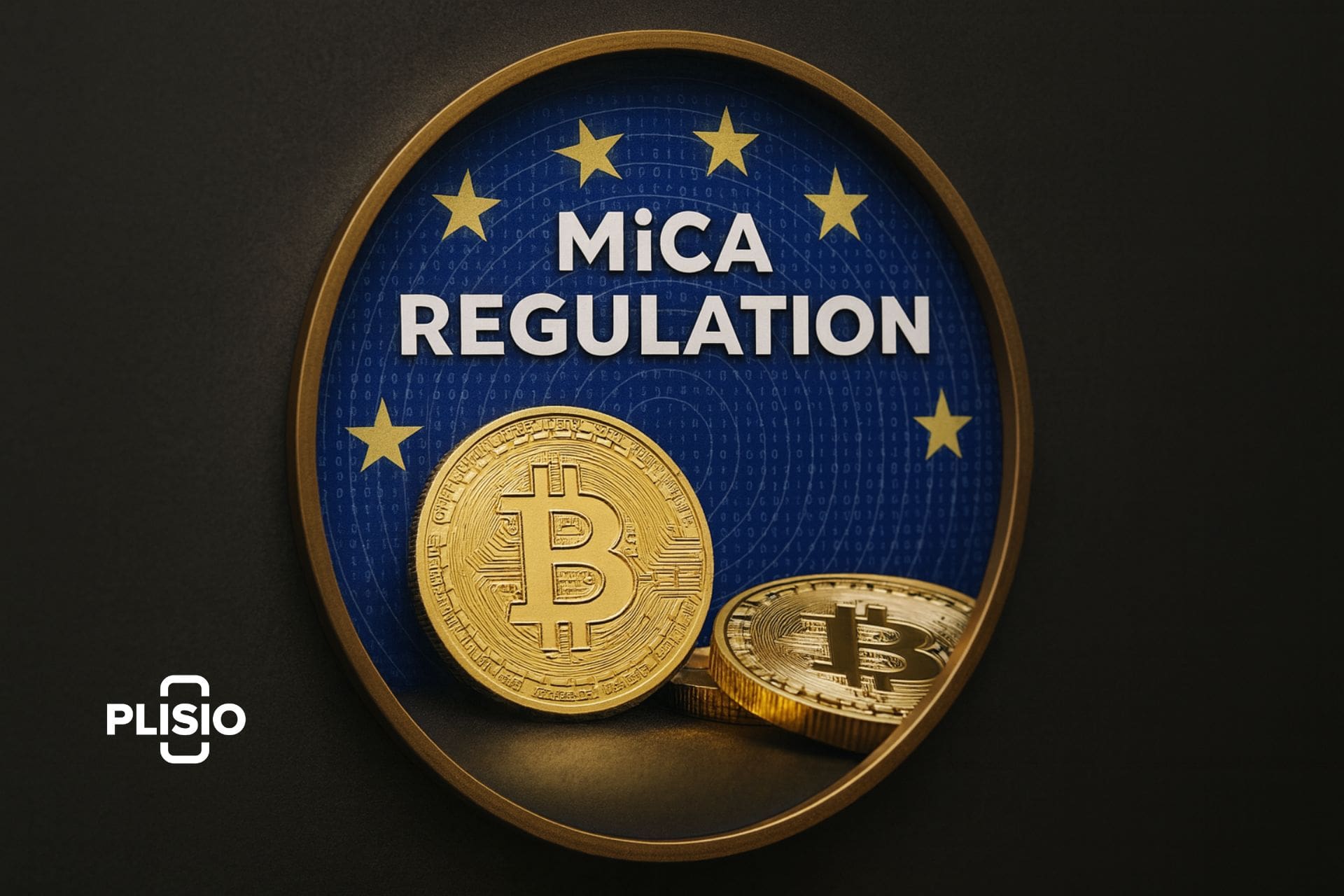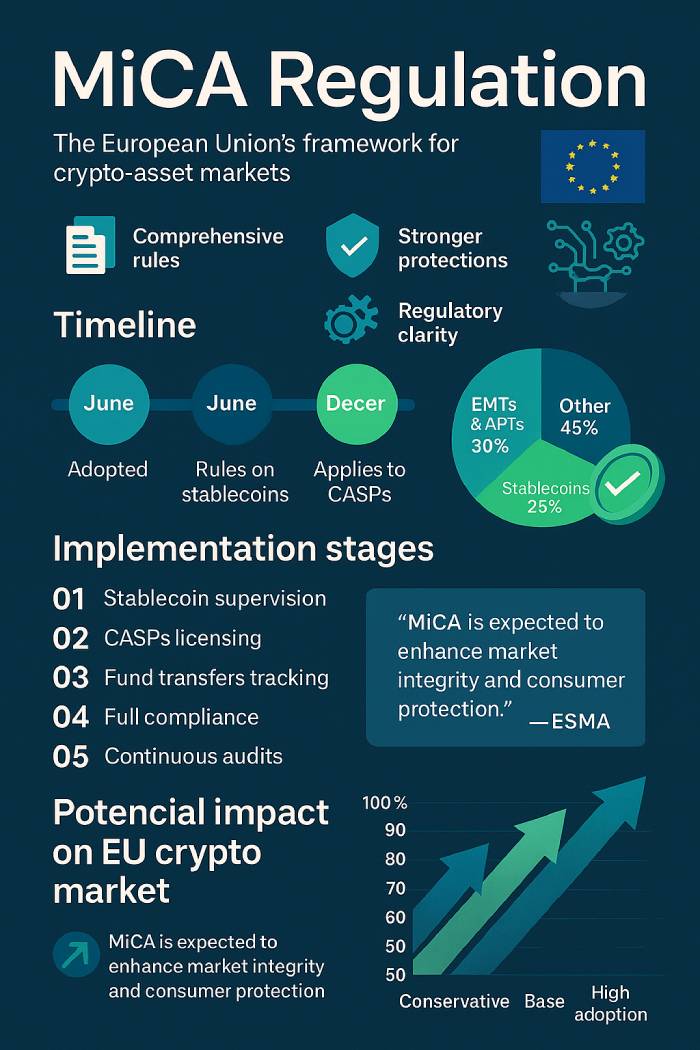Introduction to the EU Markets in Crypto-Assets (MiCA) Regulation

The Markets in Crypto-Assets Regulation (Regulation (EU) 2023/1114), or MiCA Regulation, officially came into force in June 2023, marking a turning point for EU crypto regulation. As part of the European Commission’s Digital Finance Strategy, MiCA introduces a consistent regulatory framework for the crypto industry across all EU member states. Before MiCA, crypto firms had to navigate 27 different national regimes; now, a crypto-asset service provider (CASP) authorized in one member state can operate across the EU with a single license.
In 2025, the EU crypto economy represents approximately €210 billion in market capitalization—up 18% year-on-year—and 8.9% of European adults now own crypto assets. The global crypto user base reached 861 million people, with Europe accounting for 11%. These numbers reflect a maturing market that MiCA seeks to stabilize and legitimize.
MiCA’s rollout has been phased: the first application of rules for asset-referenced tokens (ARTs) and e-money tokens (EMTs) began on 30 June 2024, with the remaining provisions for crypto-asset services becoming enforceable on 30 December 2024. However, MiCA implementation continues as the European Banking Authority (EBA), European Securities and Markets Authority (ESMA), and European Commission finalize complementary measures.
Level 2 and Level 3 Texts: Reinforcing MiCA Regulation
To ensure full compliance with MiCA, the European Commission continues to issue Delegated Regulations and Implementing Acts defining how crypto service providers and issuers of crypto-assets must meet the requirements of the MiCA Regulation. These detailed rules refine operational expectations within the EU.
Recent highlights include:
- 13 February 2025: New Delegated Regulations published, addressing complaint handling by asset-referenced token issuers and CASPs, governance for ICT systems, whitepaper approval for credit institutions, and transaction reporting for ARTs and EMTs. Cooperation between national competent authorities and non-EU regulators was also strengthened.
- 20 February 2025: Further Regulatory Technical Standards (RTS) were adopted to harmonize notification procedures for firms intending to offer to the public or operate across EU member states. These entered into force on 12 March 2025.
As of mid-2025, only 12 CASPs and 10 EMT issuers have received full MiCA authorisation—demonstrating that the compliance process remains rigorous and selective.
Pull‑quote (expert voice): ESMA has stressed that transitional permissions “do not equal passporting,” and firms should “ensure compliance” early to avoid service disruption. (Paraphrase of ESMA statements in 2024–2025.)
Scope of the MiCA Regulation and Types of Crypto Assets
MiCA regulates all crypto-assets other than asset-referenced and e-money tokens that are not considered financial instruments under MiFID II. A crypto asset is defined as a digital representation of value or rights transferable through distributed ledger technology. The types of crypto-assets governed under MiCA include:
- E-Money Tokens (EMTs): Backed 1:1 by a fiat currency and regulated under Title IV since June 2024.
- Asset-Referenced Tokens (ARTs): Pegged to multiple assets, including fiat and commodities, regulated under Title III.
- Other Crypto Assets: Including utility tokens, covered under Title II.
MiCA excludes NFTs, DAOs, and DeFi unless they functionally resemble financial instruments. However, large NFT collections or fractionalized NFTs could fall within MiCA’s remit if they are deemed fungible. As of 2025, NFTs account for 6.5% of total crypto trading volume.

Obligations for Crypto-Asset Service Providers (CASPs) Across the EU
Under the regulation on markets in crypto-assets, all CASPs must secure MiCA authorisation from their national competent authority before offering crypto-asset services within the EU. Key obligations include:
- EU Presence: A registered office in an EU member state and at least one resident director.
- Operational Resilience: Compliance with the Digital Operational Resilience Act (DORA) to maintain robust ICT and cybersecurity systems.
- Consumer Protection: Transparent pricing, risk disclosures, and fair marketing practices.
- Governance: Proper segregation of client assets, conflict-of-interest management, and audit readiness.
In 2025, the EU counts roughly 3,167 Virtual Asset Service Providers (VASPs), but 75% are expected to lose registration under MiCA’s transitional phase due to stricter requirements. CASPs with over 15 million EU users are considered significant CASPs (sCASPs), falling under ESMA supervision.
Consumer focus (new subsection): What MiCA changes for retail users
• Risk-first disclosures: standardized warnings before you trade or invest.
• 14‑day withdrawal window for certain token offers not yet admitted to trading.
• Safeguarding rules: stricter custody and asset segregation.
• Complaints handling SLAs: timelier responses and records under RTS.
• Market integrity: surveillance against market abuse (insider dealing, manipulation).
Mini‑case (illustrative): A retail user buys a utility token via a platform. Under MiCA, the platform must provide a clear, pre‑trade risk summary, display fees upfront, keep client assets segregated, and maintain a formal complaints pathway overseen by national competent authorities.
Token Issuance and Regulation of Stablecoins Under MiCA
MiCA introduces robust rules for issuers of crypto-assets, particularly stablecoins. Issuers must publish a whitepaper detailing risks and governance structures. Small-scale offerings (≤€1 million annually or to ≤150 investors) may be exempt.
Algorithmic stablecoins are prohibited under MiCA. Asset-referenced and e-money token issuers must:
- Maintain fully liquid reserves equivalent to issued tokens.
- Disclose reserves through regular audits.
- Obtain authorization from competent authorities before issuance or admission to trading of crypto-assets.
By May 2025, global stablecoin market capitalization surpassed USD 230 billion (+22% YoY). Within the EU, EMTs dominate—about 62% of stablecoin trading volume under MiCA oversight.
Pull‑quote (expert voice): The European Banking Authority has emphasized proportional, risk‑based supervision for “significant” stablecoins to protect financial stability while allowing innovation. (Paraphrase of EBA messaging.)
MiCA Transitional Measures and EU Financial Regulations
MiCA transitional measures allow firms licensed under national laws before 30 December 2024 to continue operations until 1 July 2026, pending MiCA authorisation. These transitional entities, however, do not have passporting rights across EU member states.
MiCA coexists with complementary EU financial regulations:
- DORA (effective January 2025): Enforces ICT resilience for financial institutions.
- Transfer of Funds Regulation (TFR, December 2024): Mandates that crypto service providers include sender and receiver data in all transfers.
- PSD2/PSD3: Regulators continue to assess overlaps to avoid double licensing for EMT‑related services.
Comparison (new): MiCA vs other regimes (high‑level)
Topic EU – MiCA UK – FCA (crypto) US – SEC/CFTC (crypto) Scope Horizontal rulebook for markets in crypto‑assets and crypto‑asset services AML registration + marketing rules; broader crypto regulation still evolving Case‑by‑case enforcement; tokens may be securities; state MTLs apply Passporting Single authorisation under MiCA valid across the EU No passporting; firm‑by‑firm permissions No federal passport; mosaic of state/federal rules Stablecoins ART/EMT regimes; reserves, governance, caps Proposed fiat‑backed rules under consultation Fragmented; proposals vary; pending bills Consumer Standardized disclosures; custody safeguards Financial promotions regime Enforcement‑driven disclosures
Timeline of MiCA Implementation Across the EU
June 2023: MiCA published in the Official Journal of the European Union
30 June 2024: ART/EMT rules live
30 December 2024: Full applicability
Q1 2025: First wave of RTS/ITS; licensing opens
July 2026: End of transitional period; all firms must comply with MiCA
- April–June 2023: MiCA adopted by the European Parliament, published in the Official Journal of the European Union.
- 30 June 2024: Rules for asset-referenced tokens and e-money tokens activated.
- 30 December 2024: MiCA fully effective across the EU.
- January 2025: CASPs begin applying for MiCA authorisation.
- March 2025: Additional delegated acts take effect.
- July 2026: All firms must comply with MiCA.
The Impact of MiCA Regulation on the EU Crypto Market (with Forecasts)
The Markets in Crypto-Assets Regulation (MiCA) cements the European Union’s leadership in global crypto regulation. It enhances consumer trust, strengthens EU financial stability, and creates a transparent crypto-asset market. MiCA also combats market abuse, standardizes supervision, and ensures compliance across the EU.
2025 snapshot: The European crypto market revenue is about USD 1.33 billion, with an expected 11.2% CAGR to 2030; in France, 21% of adults report owning crypto; hot wallets account for 78% of usage.
Forecasts to 2026 (scenarios):
- Base case: 150–250 CASPs receive full licenses; EU retail ownership reaches 10–12%; EMT share of EU stablecoin volume stays near 60%.
- Conservative: 90–150 CASPs licensed; ownership plateaus near 9–10% amid tighter risk‑appetite.
- High‑adoption: 250–350 CASPs licensed; ownership climbs to 12–14% as MiCA provides clearer paths to institutional products.
Next steps for teams: map your activities to MiCA regulates categories, confirm whether your tokens are crypto‑assets as financial instruments, plan MiCA compliance and documentation, and schedule readiness checks with national competent authorities.

